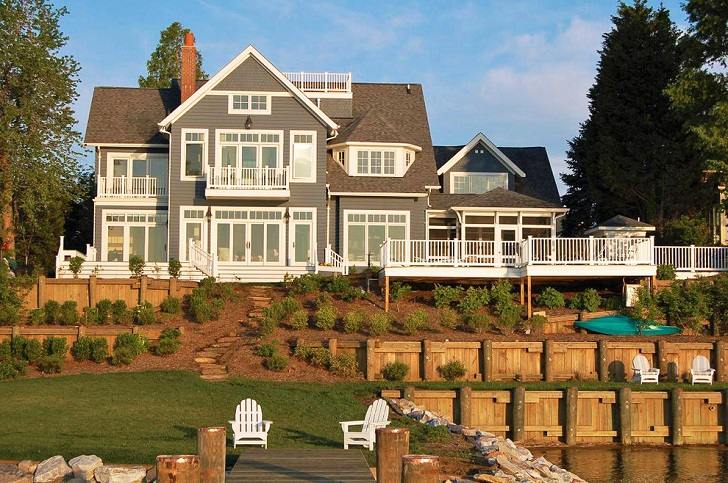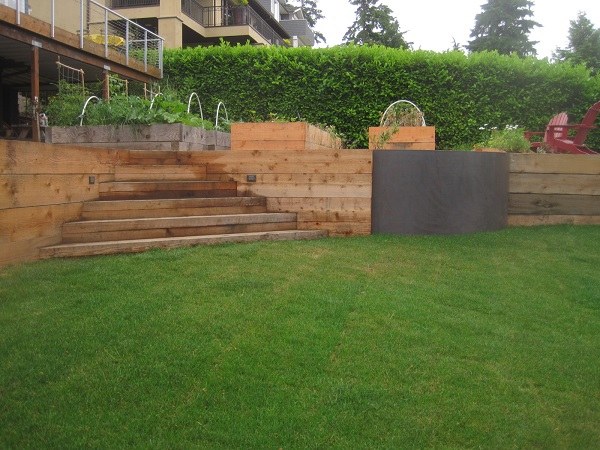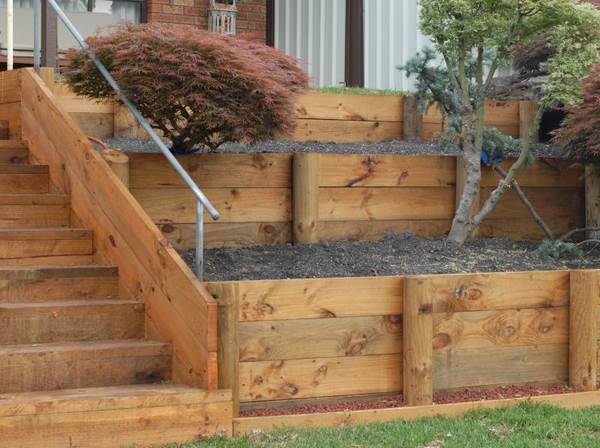Wood retaining walls are not only visually appealing but also serve as practical and affordable solutions for reinforcing slopes in landscape design projects. As a crucial element in exterior design, these walls offer a sense of harmony and beauty to any outdoor space. Homeowners and landscape designers alike value the versatility and aesthetic value that wooden retaining walls bring to a property.
Wood retaining wall ideas are always impressive with the great visual appeal and the sense of harmony in the landscape project. Such walls are an affordable and relatively simple way to reinforce slopes. In general, retaining walls are one of the most practical and beautiful elements of landscape design. As a decorative element, they are often even on flat areas and are highly valued not only by homeowners but from landscape designers as well.
How to choose a place for a wooden retaining wall? What are the advantages and disadvantages of the material? How to protect it from the negative effects of weather and elements? There are many questions that homeowners need to consider and we shall give you the answers. In the photo gallery you will be able to see beautiful examples of retaining walls made of wood and how they are incorporated in the exterior design.
Wood retaining wall ideas – choosing the right place and type of wall
The retaining wall in landscape design is an absolutely indispensable element that can not only decorate the site, but also divide it into zones. It can be a barrier and at the same time a rather original decoration of the exterior. You can build a wall from almost any material – concrete, gabions, bricks, natural stones – which are suitable for the natural conditions of soil and atmospheric phenomena of the local area, but many homeowners choose wood for its beauty and practicality.
Prior construction you need to understand the major elements of retaining walls in landscape design. Each wall consists of the following elements:
- The foundation is the most important part of the wall. The stability of the entire structure largely depends on foundation. Usually it is hidden under the ground, so it remains hidden from the eye.
- The body or the main part – brickwork, log, concrete or wood construction – this is the visible part of the retaining wall.
- Drainage – this element helps to protect the wall from the damaging effects of weather.
How to choose a place for a retaining wall? There are no limits – you can construct your wall anywhere you like. Any place is suitable except for those where moisture levels are really high. Wood is very quickly destroyed in a humid environment. For wetlands, areas with heavy snowfalls, rainfalls, spring floods of rivers and streams, under ground waters – it is better to choose an alternative and more durable material like stone or concrete. In addition, a wall made of wood is not the best choice for steep slopes where the wall will bear a great load.
How to choose the type of your wood retaining wall? There are three types of walls to choose from:
Vertical – all elements are perpendicular to the ground. They should go into the soil at a depth of minimum 30 cm, and strengthened by horizontal ties;
Horizontal – logs or beams are stacked upon each other, fastened together and the bottom row is anchored to the ground by long pieces of reinforcement which should be 0.5-1 m deep into the soil;
Combined – logs are laid horizontally between vertical posts.
The choice of the method of installation depends on several factors, the main ones being the length of the logs and whether the future wall will be curved or straight. If the logs or boards are long, horizontal laying is preferable. For complex shapes – semicircular or zigzag, for example, the vertical installation is a better choice. The boards need to be tightly fitted to each other to ensure that the decorative wall is monolithic.
Whichever type of construction you choose, you have to realize that the drainage system is essential for the lifetime and appearance of your wall. A bad drainage will increase the moisture factor is crucial for wood.
Wood retaining wall ideas – pros and cons of the material
The main task retaining walls is to prevent soil displacement down the slope. Therefore, in addition to weather effects, the wall experiences serious loads from soil pressure. Wood, like any material, has its advantages and disadvantages which homeowners need to know when choosing the materials for their landscape.
The main advantages of wood retaining walls are:
Relatively low cost;
- Visual appeal;
- Environmental friendliness;
- Easy installation – The material is suitable for a DIY project;
- Versatility – wood works harmoniously with any style and blends organically into the landscape;
- Lifetime – when properly treated, installed and maintained, your retaining wall can last for more than 20 years.
The main disadvantages of wood retaining walls are:
- Wood is a material that easily absorbs moisture. To prevent future deformation, it is necessary to make them water resistant. To do this, you can cover each log or board with a composition of hot bitumen. Another option is burning the logs. However, you will need to be extra careful not to ruin the appearance of the boards.
- Wood is susceptible to rotting, especially in hot and humid areas. Yes, nowadays, the market offers pressure treated wood, which is more durable, but sooner or later you will need to renew or replace the wall.
- As we mentioned before, wood is not a good choice for retaining walls with more complex shapes, as it is not as strong and durable as alternative materials like metal or stone.
- Low quality wood will degrade quickly.
- Wood is susceptible to insect attacks. Termites, for example
Frequently Asked Questions
1. Where is the best place to construct a wooden retaining wall?
Wooden retaining walls are not suitable for areas with high moisture levels. Avoid wetlands, regions with heavy snowfalls, or locations prone to spring floods. For such areas, more durable materials like stone or concrete are recommended.
2. What are the different types of wood retaining walls?
There are three main types of wood retaining walls – vertical, horizontal, and combined. Each type has its own installation method and is chosen based on factors like the length of the logs and the desired shape of the wall.
3. What are the essential elements of a wooden retaining wall?
A wooden retaining wall consists of a foundation, the main body, and a drainage system. The foundation provides stability, the main body is the visible part of the wall, and drainage protects the wall from weather damage.
4. What are the advantages of using wood for retaining walls?
Wood retaining walls are visually appealing, environmentally friendly, versatile, and relatively easy to install. They blend well with any landscape style and can last for over 20 years with proper maintenance.
5. How can wood retaining walls be protected from moisture and rot?
To protect wood from moisture and rot, it needs to be made water-resistant. This can be achieved by coating the wood with a water-resistant sealant or using pressure-treated wood. Regular maintenance is also essential to prevent decay.
6. Are there any disadvantages to using wood for retaining walls?
Wood is susceptible to rot, insect attacks, and deformation due to moisture absorption. It may not be suitable for retaining walls with complex shapes or areas with high humidity levels. Low-quality wood can degrade quickly and require frequent replacement.
7. What is the typical lifespan of a wood retaining wall?
With proper treatment, installation, and maintenance, a wood retaining wall can last for more than 20 years. Regular inspections, repairs, and protective measures against moisture and pests can extend the lifespan of the wall.




